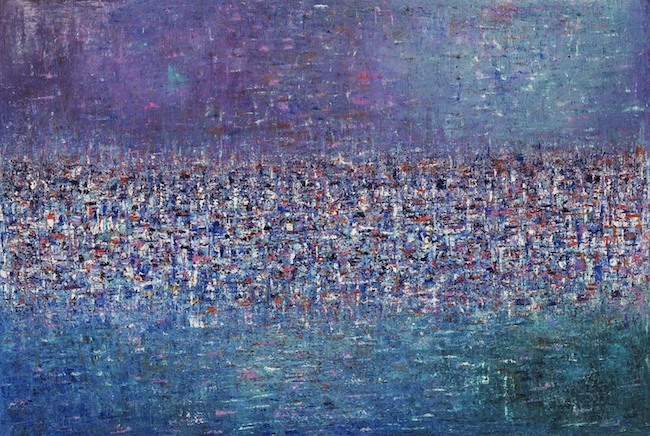Tra gli artisti contemporanei si delinea a volte una demarcazione tra chi in qualche modo celebra e accoglie tutto ciò che la società rappresenta, compreso il senso di appartenenza a un progresso tecnologico, a un vivere urbano in cui sentirsi esploratori e narratori, e chi invece avverte il disorientamento della mancanza di individualismo, di capacità di mantenere un legame con le pulsioni interiori, con i desideri e i sogni che si disperdono all’interno della quotidianità e della corsa verso la vita che spesso dimentica l’essere umano. La protagonista di oggi appartiene a questa seconda categoria di creativi e trasforma la sua manifestazione pittorica in esplosione cromatica della poliedricità di emozioni che non dovrebbero mai essere messe in ombra dalla routine del vivere.
Intorno alla metà degli anni Cinquanta del Novecento alcuni artisti, soprattutto nelle grandi città statunitensi, cominciarono ad avvertire il peso di una società in cui tutto sembrava essere diviso, in cui le città con i loro grattacieli e le strade asfaltate erano da un lato rappresentative di una corsa verso il consumismo e il successo personale, dall’altro invece rappresentavano il luogo in cui chi non riusciva a entrare nel meccanismo della realizzazione professionale e sociale restava ai margini, rifugiandosi nelle vie delle periferie e sentendo aumentare la rabbia per quell’essere esclusi da un mondo che andava verso una direzione per loro irrealizzabile. La consapevolezza di questo disagio, di queste profonde differenze e di quelle emozioni negative indusse alcuni creativi a dare sfogo al loro malessere disegnando e dipingendo sui muri dei ponti, dei palazzi e ovunque fosse possibile, quelle sensazioni, per far sapere al mondo ignaro che anche loro esistevano e che avevano molti più colori di quanto ne avessero gli impiegati che ogni mattina percorrevano il medesimo percorso ed entravano nel medesimo ufficio. Quei murales presero il nome di Street Art, un fenomeno artistico forte e incisivo che ha continuato a evolversi anche nella contemporaneità; ciò che colpì di questo tipo di arte di cui Jean-Michel Basquiat fu precursore e grande rappresentante, fu non solo la rabbia nascosta all’interno di quei graffi o il bisogno di accettazione celato nelle figure piccole e indefinite di Keith Haring, bensì la necessità di riempire di colori il grigio della quotidianità, facendo così sentire la propria voce. Il tema dell’espressività, del dover liberare emozioni e sensazioni in maniera spontanea senza alcuna regola accademica fu comune anche a un altro movimento coevo dello stesso periodo, l’Espressionismo Astratto, in cui le tele dovevano semplicemente essere mezzo e base per permettere a ciascun artista di manifestare più o meno impulsivamente la propria interiorità, attraverso il colore che si uniformava all’inarrestabile sentire, alle pulsioni che necessitavano di essere narrate. L’artista modenese Paola D’Antuono si riallaccia alle intenzioni espressive degli Street Artist per contrastare il grigiore dei paesaggi urbani che appartengono alla contemporaneità tanto quanto al secolo scorso, ma lo fa sulla tela, dunque la similitudine è più nell’approccio filosofico e sociologico che non nella realizzazione in esterno, e con un linguaggio che rientra a pieno diritto nell’Espressionismo Astratto più vicino al Color Field di Mark Rothko che non all’Action Painting di Jackson Pollock.
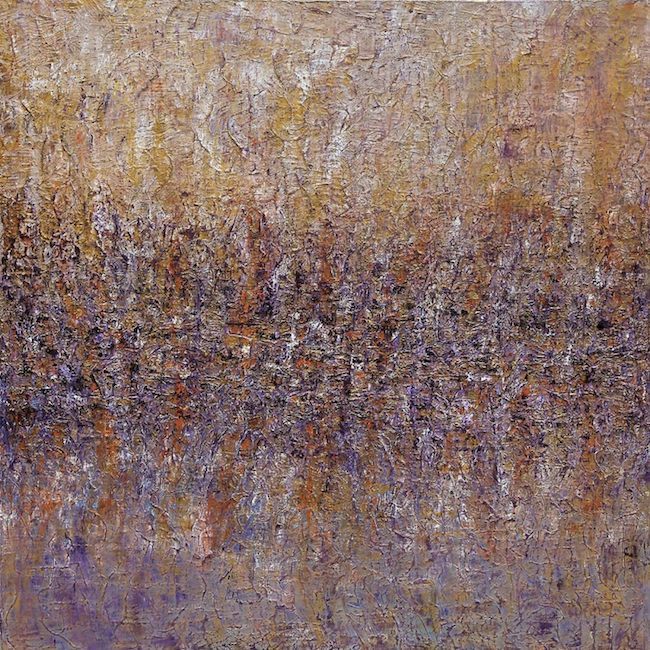
Ciò che conta per la D’Antuono è rappresentare attraverso le variazioni cromatiche l’intensità del sentire, la vivacità di un’esistenza che non può essere messa in secondo piano da una routine grigia e anonima, di un paesaggio cittadino in cui si dimentica la vitalità di una natura lontana eppure in grado di assecondarsi al sentire dell’essere umano.
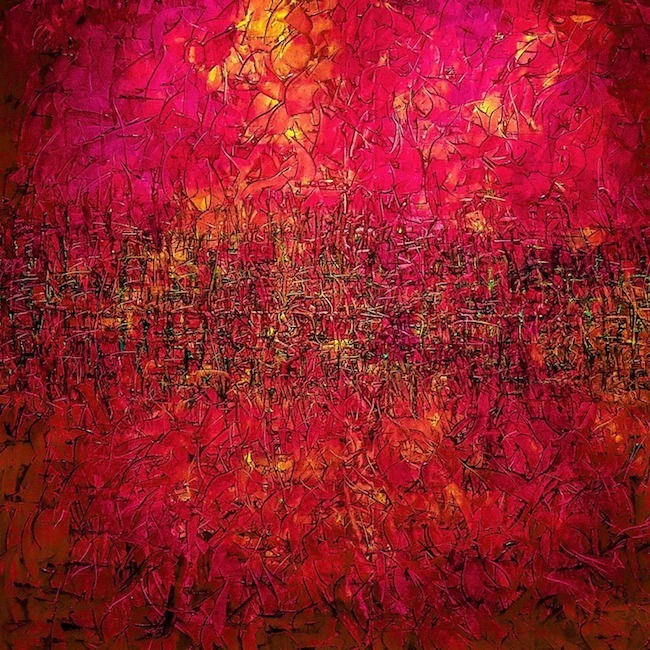
La stesura sulla tela è netta, definita e quasi scolpita pur dando una sensazione di morbidezza sfumata anche quando le emozioni raccontate sono profonde, intense, oppure si accordano alle sensazioni ricevute nel momento in cui il suo sguardo si è posato su un paesaggio, su un panorama narrato attraverso il filtro interiore, quello in cui non è importante la rappresentazione esteriore piuttosto lo è l’accordo delle tonalità alle vibrazioni interiori percepite.
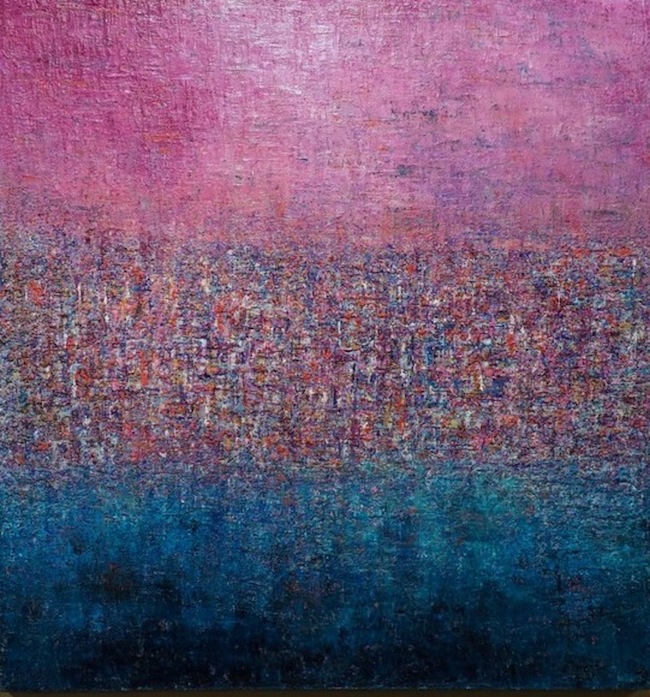
Nella tela Sul far del giorno l’artista esprime la meraviglia che prova nei confronti di un fenomeno che si ripete quotidianamente, l’alba, pur mantenendo una bellezza incontaminata, sorprendente agli occhi di chi è in grado di coglierne la purezza spontanea che va ben oltre l’abitudine visiva; è questa l’esortazione della D’Antuono, di non dimenticare mai di cogliere quei dettagli trascurabili che in realtà possono rendere ogni giorno una meravigliosa avventura, un modo per aprirsi a quelle emozioni che diversamente sarebbero nascoste e lasciate silenti per privilegiare gli impegni da rispettare, i compiti da svolgere, la fretta del vivere. Le tonalità sono quelle dell’anima, quegli azzurri e quei violetti che si legano all’interiorità e le permettono di palpitare, di osservare non solo con gli occhi bensì con l’apertura della parte emotiva, quella per cui non conta che la terra sia marrone, il cielo azzurro e il prato verde se la profondità percepisce l’osservato in maniera differente; ed è esattamente la sensazione che si riceve guardando la tela, che racconti un luogo non luogo che può essere qui o altrove, ovunque l’occhio riesca a percepire l’emozione.
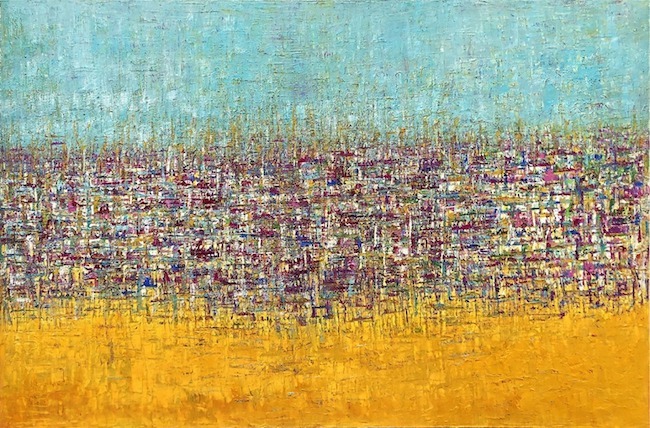
In Una giornata estiva invece Paola D’Antuono sceglie tonalità fresche, vivaci, gioiose proprio come lo è la stagione delle vacanze, delle giornate all’aperto, del risveglio della natura che si dona in tutto il suo splendore allo sguardo dell’artista e anche di tutti coloro i quali riescono a farsi trasportare e avvolgere dalla naturalezza e dalla piacevolezza dei paesaggi intorno a sé; i colori principali sono il giallo del grano, l’azzurro del cielo e il violetto misto ai toni neutri della terra, delle piante, della vita che emerge e che si pone al centro della tela, sospesa per sottolineare l’accoglienza dell’elemento naturale nei confronti dell’essere umano che lo abita.
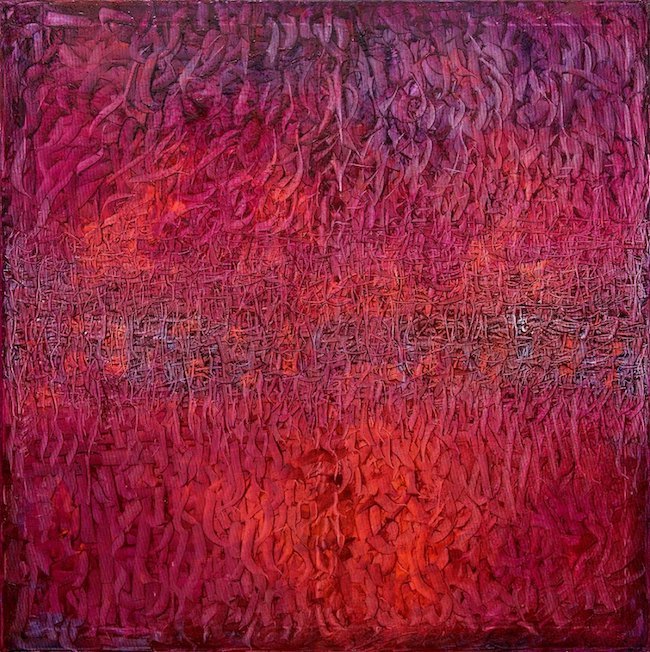
Le sottili linee orizzontali e verticali che si intrecciano a formare un lieve reticolo rappresentano i condizionamenti, la rete di convinzioni a cui spesso l’individuo si aggrappa per il timore di non essere uniformato a ciò che la società chiede, dimenticando però, in quell’intreccio, di lasciarsi spazio per la propria individualità, per i propri desideri; la tecnica che prevalentemente Paola D’Antuono utilizza è quella della spatola con cui mescola colori a olio e pigmenti, in virtù della quale la sua spinta espressiva si libera, si manifesta in tutta la sua pienezza, così come la sua esortazione all’uomo contemporaneo a mantenere il contatto con quella singolarità che gli permetterà sempre di esprimere la sua vera essenza.
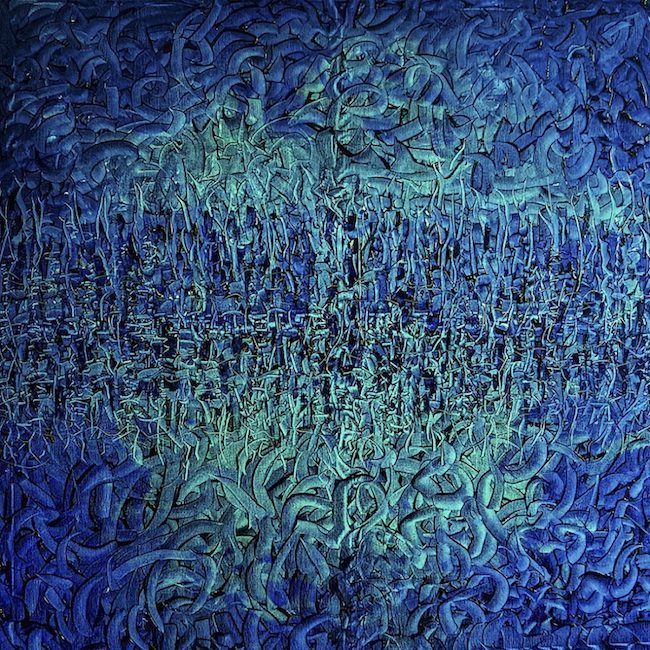
Nella tela Gli abissi dell’anima l’artista si sposta dal tema del paesaggio interiorizzato e volge verso le profondità più intime quel mondo sotterraneo che domina, inevitabilmente, l’esistenza umana e resta un mistero solo parzialmente svelato persino a se stessi, proprio perché nel vivere attuale sembra essere diventato più semplice restare in superficie, galleggiare e mantenere una facciata meno impegnativa, meno necessitante di un percorso introspettivo a volte anche doloroso ma sempre essenziale per conoscersi ed evolvere. I fitti intrecci, quei tubolari contorti su se stessi rappresentano le complessità di tutto il bagaglio emotivo che ciascun individuo porta all’interno di sé, quelle frange di ricordi e di collezione di frammenti di esperienze che vanno ad alimentarsi vicendevolmente e che, proprio a causa della loro consistenza spesso spaventano inducendo l’essere umano a trattenerle e a nasconderle.
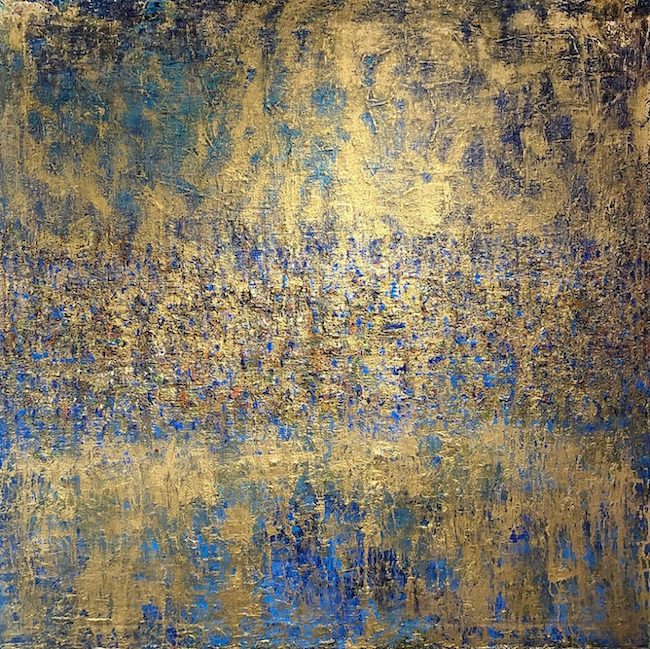
Paola D’Antuono ha all’attivo la partecipazione a moltissime mostre collettive su tutto il territorio nazionale, ha preso parte a una video esposizione a New York e le sue opere sono state selezionate per essere inserite nell’edizione 2021 dell’Atlante dell’Arte Contemporanea De Agostini, dell’Enciclopedia dell’Arte Italiana e dell’Annuario dell’Arte Italiana Mondadori Artisti 2020-2021.
CONTATTI-PAOLA D’ANTUONO
Email: dapaol65@gmail.com
Sito web: www.paoladantuono.it
Facebook: https://www.facebook.com/paola.dantuono.3
Instagram: https://www.instagram.com/paola.dantuono.3/
The power of colour to contrast the grey of urban landscapes in Paola D’Antuono’s Abstract Expressionism
Among contemporary artists there is sometimes a demarcation between those who in some way celebrate and welcome everything that society represents, including the sense of belonging to a technological progress, to an urban living in which they feel like explorers and storytellers, and those who instead feel the disorientation of the lack of individualism, of the ability to maintain a link with inner drives, with desires and dreams that are dispersed within everyday life and the race towards existance that often forgets the human being. Today’s protagonist belongs to this second category and transforms her pictorial manifestation into a chromatic explosion of the multifaceted nature of emotions that should never be overshadowed by the routine of living.
Around the mid-1950s, some artists, especially in the big cities of the United States, began to feel the weight of a society in which everything seemed to be divided, in which cities with their skyscrapers and asphalt roads were on the one hand representative of a race towards consumerism and personal success, on the other hand, they represented the place where those who could not enter the mechanism of professional and social fulfilment remained on the fringes, taking refuge in the streets of the suburbs and feeling an increasing anger at being excluded from a world going in a direction that was unattainable for them. The awareness of this discomfort, of these profound differences and negative emotions led some creative people to give vent to their unease by drawing and painting on the walls of bridges, buildings and wherever possible, those feelings, to let the unsuspecting world know that they too existed and that they had many more colours than the office workers who walked the same route every morning and entered the same office. Those murals became known as Street Art, a strong and incisive artistic phenomenon that has continued to evolve even in the present day. What struck us about this type of art, of which Jean-Michel Basquiat was the forerunner and a great representative, was not only the anger hidden within those scratches or the need for acceptance concealed in Keith Haring’s small, undefined figures, but rather the need to fill the grey of everyday life with colour, thus making his own voice heard.
The theme of expressiveness, of having to release emotions and sensations in a spontaneous manner without any academic rules, was also common to another contemporary movement of the same period, Abstract Expressionism, in which canvases simply had to be a means and a base to allow each artist to more or less impulsively manifest his interiority, through colour that conformed to the unstoppable feeling, to the impulses that needed to be narrated. The Modenese artist Paola D’Antuono draws on the expressive intentions of the Street Artists to contrast the greyness of the urban landscapes that belong to the contemporary world as much as to the last century, but she does so on canvas, so the similarity lies more in the philosophical and sociological approach than in the outdoor realisation, and with a language that rightfully belongs to Abstract Expressionism, closer to Mark Rothko’s Colour Field than to Jackson Pollock’s Action Painting. What counts for D’Antuono is to represent, through chromatic variations, the intensity of feeling, the vivacity of an existence that cannot be overshadowed by a grey and anonymous routine, of a cityscape in which the vitality of a distant nature is forgotten, yet one that is able to go along with the feeling of the human being. The drafting on the canvas is sharp, defined and almost sculpted, while giving a feeling of softness and nuance even when the emotions narrated are profound and intense, or are in tune with the sensations received at the moment when her gaze rests on a landscape, on a panorama narrated through the inner filter, one in which it is not the external representation that is important, but rather the harmony of the tones with the interior vibrations perceived.
In the canvas Sul far del giorno (At the break of day), the artist expresses the wonder she feels towards a phenomenon that is repeated daily, the dawn, while maintaining an uncontaminated beauty, surprising to the eyes of those who are able to grasp its spontaneous purity that goes far beyond visual habit; this is D’Antuono’s exhortation, never to forget to capture those negligible details that can actually make every day a wonderful adventure, a way of opening up to those emotions that would otherwise be hidden and left silent in favour of commitments to fulfil, tasks to perform, the rush of life. The colours are those of the soul, those blues and violets that connect with the inner self and allow it to palpitate, to observe not only with the eyes but with the openness of the emotional side, the one for which it does not matter that the earth is brown, the sky blue and the grass green if the depth perceives the observed in a different way; and this is exactly the sensation that one receives when looking at the canvas, which tells of a place that is not a place that can be here or elsewhere, wherever the eye can perceive the emotion. In Una giornata estiva (A Summer’s Day) Paola D’Antuono chooses fresh, lively, joyful colours, just like the holiday season, the days spent outdoors, the reawakening of nature, which gives itself in all its splendour to the eye of the artist and of all those who manage to be transported and enveloped by the naturalness and pleasantness of the landscapes around them; the main colours are the yellow of the wheat, the blue of the sky and the violet mixed with the neutral tones of the earth, of the plants, of the life that emerges and stands at the centre of the canvas, suspended to emphasise the acceptance of the natural element towards the human being who inhabits it.
The thin horizontal and vertical lines that intertwine to form a slight grid represent the conditioning, the network of beliefs to which the individual often clings for fear of not being conformed to what society demands, forgetting, however, in that interweaving, to leave room for their individuality, for their desires; the technique that Paola D’Antuono mainly uses is that of the spatula with which she mixes oil colours and pigments, by virtue of which her expressive drive is released, manifested in all its fullness, as is her exhortation to contemporary man to maintain contact with that singularity that will always allow him to express his true essence. In the painting Gli abissi dell’anima (The Abysses of the Soul), the artist moves away from the theme of interiorised landscape and turns towards the most intimate depths of that subterranean world which inevitably dominates human existence and remains a mystery only partially revealed even to oneself, precisely because in today’s life it seems to have become easier to remain on the surface, to float and maintain a less demanding facade, less requiring of an introspective path, at times even painful but always essential for knowing oneself and evolving. The dense weaves, those twisted tubulars represent the complexities of all the emotional baggage that each individual carries within him or herself, those fringes of memories and collections of fragments of experiences that feed off each other and which, precisely because of their consistency, often frighten human beings into holding them back and hiding them. Paola D’Antuono has taken part in many group exhibitions throughout Italy, has taken part in one video exhibitions in New York and her artworks have been selected for inclusion in the 2021 edition of the Atlante dell’Arte Contemporanea De Agostini, the Enciclopedia dell’Arte Italiana and the Annuario dell’Arte Italiana Mondadori Artisti 2020-2021.


